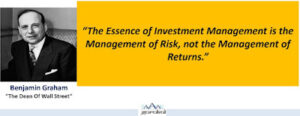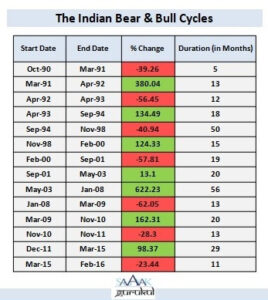“The biggest risk is not taking any risk.” Profound words indeed!
You need to look in the mirror and answer, Are you taking enough risks to meet your goals?
Although it is often used in different contexts, Risk is the possibility that an outcome will not be as expected. Specifically in finance, it is always discussed with reference to returns on your investment. Risk implies future uncertainty about deviation from expected earnings or expected outcome. Risk measures the uncertainty that an investor is willing to take to realize a gain from an investment.
Great things never come from being in your Comfort zone. In order to grow, we need to take risks, whether in businesses or in our careers.
Generally we take risks because there’s a gap between where you are now and where you want to be.
Risk and return go hand in hand and have a direct correlation, you want to become rich and grow your wealth, you must take the necessary risks.


Most investors consider risk only as loss of capital or the reduction in corpus, whereas to assess risk in the true sense, we need to also consider the risk in valuation of the corpus or reduction in purchasing power due to inflation and also the opportunity cost of capital. The benchmark for inflation should not be the Government sponsored WPI or CPI but also factor in the Lifestyle inflation.
As I’am fond of saying in most investor interactions, “Ten years ago, who would have thought that we will buy a Rs 50000 phone on a whim or as a Gift for a loved one every year.” Hence the need to factor in lifestyle inflation in your investment strategy.
While comparing investment options, we have experienced that most investors also ignore the tax implications and the impact taxes can have on the erosion of the corpus. Another impact, taxes have, is on the values at which your corpus will compound every year.
Taxes on Interest income are on accrual whereas taxes on mutual funds or equity are on redemption thereby impacting the value of the corpus at the end of each year. E.g. Lets say you have Rupees one lakh and you buy an FDR @ 6%, your corpus would grow to Rs 106000 less tax @ 30% i.e. Rs 104200 and next year you would get interest on Rs 104200. The same amount invested in a Debt Fund @ 6%, would also grow to Rs 106000, but because tax is only applicable if you redeem, next year also you would get interest on Rs 106000. The investment over a period of 5 years will lead to a substantial difference due to this factor alone.
Hence, as a first rule, your investment must generate a return, which beats inflation post taxes. If you are not able to do that, then you run the risk of losing the purchasing power of your investment even if your corpus remains intact.
Between the two major financial asset classes, Equity and Debt, Equity is generally associated with risk and Debt with safe and steady returns.
The problem arises when the investor starts taking risks in Debt Investment. The risk in Debt has been highlighted by the recent FMP crisis and the NBFC defaults, wherein the investors have lost or are very close to loosing their hard earned corpus invested in “Safe” Debt.
Risk is for equity and should deliver the option of higher returns but alas, for a few extra basis points or an extra percentage return, investors end up investing in low credit and below par Debt instruments thereby also exposing themselves to the risk of default.
The portion you need to invest in Debt as a part of your Asset allocation strategy, should be in low risk or virtually zero risk options like Government Bonds, FDRs, PPF, Arbitrage and liquid funds and the like. Please don’t look at an extra return on your Debt investment and always remember that a higher return can only come with a higher risk.
The Problem is not taking too much risk but taking too less risk or taking risk where it is not required or in the wrong asset class.
Indian investors have been playing too safe with their investments. Our investments are dominated by Debt, our portfolios are largely concentrated in FD’s, PPF, RD’s, traditional endowment insurance policies (since we get a fixed amount on maturity), Post Office Schemes, etc.


Warren Buffett said “Risk comes from not knowing what you are doing”
You need to understand the vagaries of different asset classes, the risk and return matrix of each option, to make a wise investment choice and decision.
Numerous studies and the chart below also clearly illustrates that no asset class can beat Equity in terms of returns in the long term. Sensex has grown almost 390 times in its 40-year journey from 1979 as compared to 35 times in Gold and 22 times in FD.


However the growth in the Sensex has not been linear, rather it has been volatile, with a lot of ups and downs; prolonged periods of stagnation and sudden spurts of growth. But that is the inherent nature of this asset class due to the large number of variables, which determine the stock price. Investors tend to lose patience and give up midway. They also ignore the fundamental rules of the market; i.e. stock price always follows earnings and whatever the volatility, the price will always tend to reverse to the mean valuation.
A study of the history of the equity and other asset classes helps us study the probability of loss while investing in an asset class. One of the major determinants of the choice of asset class is dependent on the time horizon you have to reach your goal. To get the best returns from Equity, you need to give it a minimum of five years and above as is evident from the chart below.


The probability of loss in Equity Mutual Funds becomes zero in 5 years, whereas in Sensex, it is only 9% after 5 years and progressively reduces to zero in 12 years.


The 2008 Stock market crash was one of the biggest crashes in the recent history of the stock markets. The Sensex reached its peak level on 8thJan 2008 when it touched 20873. Subsequently when the financial crisis unfolded, the markets dropped by close to 65% to reach the lowest level wherein it hit 7,697.39 intraday and closed the day at 8,509.56 on Oct 27, 2008. After touching a low of 7,697.39 on Oct 27,2008 Sensex slowly recovered to re-scale 21,000 on Nov 5, 2010 thereby erasing all losses in less than three years.
Lets take two scenarios; in the first scenario, lets assume that you were unlucky and you bought the Sensex on 8thJan @ 20873. Subsequently the market started crashing and you held onto the Sensex for 10 years. On 8th Jan, 2018, it had reached a level of 34353 thereby giving you an absolute return of 65% and a CAGR of 5.11%
In the second scenario, lets assume that you sold at the lowest point of the market, on 27thOct 2018at a Sensex level of 8000. If you had bought it Five years ago the Sensex, on the same day, was @ 4698.28, thereby giving you an absolute return of 70% and a CAGR of 11.23%.
Hence, even if you buy at the highest point or sell at the lowest point of the market, if you have a five-year horizon and more, you will have a lesser probability of losing money in the equity market.
According to a study done by investment firm Deutsche Bank, the stock market, on an average, has a correction every 357 days, or about once a year. While many investors, especially those new to Equity investing simply aren’t used to experiencing swings like these, but corrections are an inevitable part of stock market.
However, these corrections offer a major opportunity to buy and gain substantial returns in the next one to three years.


In a broader context, while a stock market correction is an inevitable part of stock ownership, corrections last for a shorter period of time than bull markets.
Based on research conducted on the Dow between 1945 and 2013, John Prestbo at MarketWatch determined that the average correction (which worked out to 13.3%) lasted a mere 71.6 trading days, or about 14 calendar weeks. The Indian Bear & Bull cycles are also highlighted below and also show a similar trend.


Hence Equity is also not risky if you have the conviction in the asset class, understand the market dynamics, have the patience and have a long-term horizon. You may only need the help of a financial advisor who can help you ride the volatility. He will also help you make investment decisions based on the current market valuations.
Historically NIFTY trades at PE of 18 and gives the best return when it trades near or below the historical levels.


As is evident from the above data, long term Equity investment can balance the risk and provide better returns if you have the right time horizon.
If your horizon is less than five years, you need to shift to Debt or safer asset classes.
However, most investors stick with debt despite having a longer time horizon. The problem with being too conservative is, it leads to sub optimal returns over the long term, which may hamper the achievement of your financial goals.
The risk quotient is always subjective; it varies from case to case. The Risk should be in conjunction with the returns you need.
The Golden Rule is Young Investors should take more Risk and the older ones should take less risk. The real risk actually arises when the value of your investment is less than the value of your goal. Of what use will be a retirement corpus, created after saving since the last 30 years in 6% FDs, when it will only be enough to last the next 10 years only, post retirement, when even an additional 4% return created from balancing risk, would have lasted for more than 25 years.
What would you prefer for your retirement fund after investing Rs 10000 every month for 30 years; Rs 107 lacs or Rs 563 lacs especially when you know the probability of loss in equity after 10 years is negligible.


The risk you should take is dependent upon a number of factors, viz.
Your financial position: income, expenses, assets, liabilities; Family responsibilities; Your age; The time you have in hand for your goal, your own risk profile and many such factors.
You must understand that there are different kinds of risks, some controllable and some beyond your control.


Ideally, asset allocation has to play an important role in your investment journey. Consult your wealth manager or financial advisor to help you choose the most suited asset allocation strategy for you.A sound Asset allocation strategy will help you optimize the risk,you need to take to achieve your financial goals.


There are other asset classes also available, like Real Estate, Gold, Commodities etc. but the biggest drawback in them is lack of Liquidity, Big-ticket size, leading to issues of affordability, inadequate diversification and taxation disadvantages.
Where should you invest – Finally it boils down to; are you achieving financial goals or not. The Objective is not to beat the benchmark all the times but to achieve the financial goals.
The bottom-line is, if there is a difference between your risk appetite and the risk you require to take to achieve your financial goals, you need to bridge the gap. Sometimes, it is ideal to take risk even at a later age to achieve the goals and create wealth. To have the required money to actualize our dreams, we must take the necessary risk.
I remember an old saying, “20 years from now you will be more worried about the things you didn’t do rather than the ones you did.”
So, are you taking enough risk?
Consult your financial advisor today and optimize your risk return balance to achieve your financial goals.
Happy Investing!
Stay Blessed Forever!
Sandeep Sahni


Kindly check our earlier blog on a similar subject : Investment Lessons from Mythology at https://sahayakgurukul.blogspot.com/2019/03/investment-lessons-from-mythology.html OR https://www.sahayakassociates.in/resources/our-blog/2553-sahayak-associates/sahayak-associates-blog/8435-investment-lessons-from-mythology
Note: All information provided in this blog is for educational purposes only and does not constitute any professional advice or service. Readers are requested to consult a financial advisor before investing as investments are subject to Market Risks.
About The author

Sandeep Sahni
After completing his schooling from St. Johns, Chandigarh (Class of 1980) and Modern School, New Delhi, (Class of 1982) Sandeep did his B. Com (Hons.) from Shri Ram College of Commerce, Delhi University (Class of 1985)
Sandeep is an alum of IIM Lucknow with a Post Graduate Degree (MBA class of 1988).
He has also written two books, ‘Dear Son, Life Lessons from a Father’ on the teachings of Life https://www.amazon.in/dp/1637815271 and the Second book which he has Co Authored titled, ‘What My MBA Didn’t teach me about Money’ on the Human and Financial perspective of money. https://www.amazon.in/dp/1637816502
He has a rich work experience and started his career as a corporate man with Asian Paints after IIML. He has a rich experience covering the FMCG, Food Distribution, Cold Chain, Logistics, and Hospitality Industries. He is currently in the Wealth Management and Personal Finance domain. He has a passion for finance and is an active speaker on topics in finance. The stories he narrates strike a chord close to his heart, as they are based on events from his own life. He believes in a holistic view of Personal Finance.
Sandeep’s investing experience and study of the Financial Markets spans over 30 years. He is based in Chandigarh and is advising more than 500 clients across the globe on Financial Planning and Wealth Management.
He has promoted “Sahayak Gurukul” which is an attempt to share thoughts and knowledge on aspects related to Personal Finance and Wealth Management. Sahayak Gurukul provides financial insights into the markets, economy and Investments. Whether you are new to the personal finance domain or a professional looking to make your money work for you, the Sahayak Gurukul blogs and workshops are curated to demystify investing, simplify complex personal finance topics and help investors make better decisions about their money.
Alongside, Sandeep conducts regular Investor Awareness Programs and workshops for Training of Mutual Fund Distributors, and workshops and seminars on Financial Planning for Corporate groups, Teachers, Doctors and Other professionals.
Through his interactions and workshops, Sandeep works towards breaking the myths and illusions about money and finance.
His passion has driven him towards career counselling for young adults and mentoring the youngsters on achieving their life goals and becoming “Successful Humans”
He also writes a well-read blog; https://sahayakgurukul.blogspot.com
He has also conducted presentations, workshops and guest lectures at professional colleges and management institutes for students on Financial Planning and Wealth Creation.
He can be reached at:
+91-9888220088, 9814112988,
sandeepsahni@sahayakassociates.in
Follow on:
www.sahayakassociates.in,
www.facebook.com/sahayakassociates,
www.twitter.com/sahayakassociat,https://www.instagram.com/sahayakassociates/
https://sahayakgurukul.blogspot.com, https://www.sahayakassociates.in/resources/our-blog




